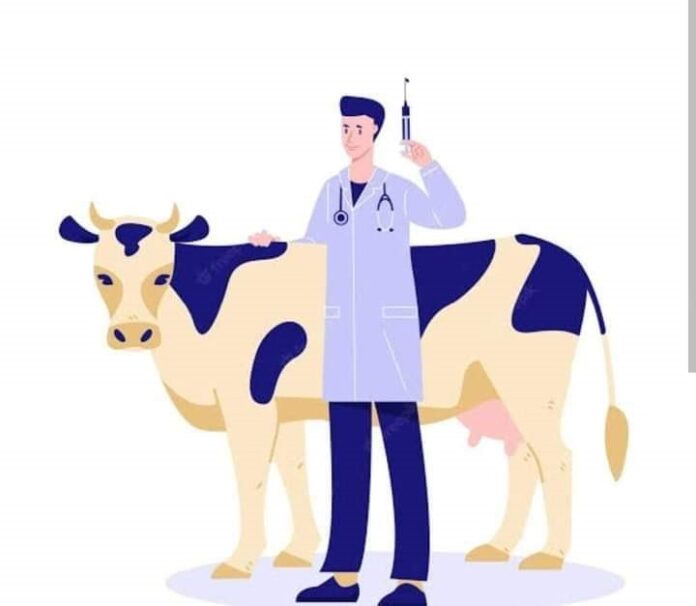Thiamine Deficiency in sheep and goat
Goats and sheep are small ruminants, herbivorous animals. Goats and sheep will graze grass and browse forbs (weeds and wild flowers) and brush closer than other herbivores and thus require more intense grazing management. Goats tend to browse vegetation of higher quality than do cattle. Sheep are fairly selective feeders, preferring grasses/pastures and forbs; goats, on the other hand, are mainly browsers, preferring shrubs and forbs. Goats and sheep “sort” grain mixes, selectively choosing preferred ingredients, and therefore should be fed pelletized or textured feeds. Goats like to eat with their heads up and will select portions with higher nutrient content. Goat and sheep husbandry play an important role in rural economy. Both the animals have been popularly described as Mortage lifters of India.
Thiamine (Vitamin B1) is naturally produced in the rumen of the goat by the ruminal microorganisms and so as a dietary supplement, is not required with proper functioning rumen (Brent and Bartley, 1984). However under certain conditions thiamine production may decrease and/or available thiamine may be destroyed leading to it’s deficiency. Thiamine deficiency or “Polioencephalomalacia (PEM)” or “Goat Polio” or “Cerebrocortical Necrosis”, is a common metabolic disorder characterized by neuromuscular alterations in the thiamine deficient of goats. This disorder may be acute or sub-acute in nature. Adult and young animals are equally at high risk for developing the disorder. Goat polio is usually seen in animals that are under high nutritional management condition such as feedlots, or animals on lush pasturage fed with highly concentrated rations (Dana et al., 2010). Like all B vitamins, B1 is a water soluble vitamin and is a major part of the several enzymes for carbohydrates and amino acid metabolism in the rumen as well as the nervous system and muscles. Thus, thiamine deficiency causes nerve weakness and partial paralysis of the legs.
Thiamine deficiency can result (B1 deficiency) can result in a condition called polioencephaomalacia or sheep/goat polio for short. This polio is a disease of the central nervous system caused by a Vitamin B1 deficiency. Since the rumen manufactures B Vitamins, the polio is not caused by insufficient thiamine but instead the ability to synthesize it properly in the rumen. Thiamine deficiency can develop in healthy lambs and kids when the following factors are taking place:
(1)Stress from weaning or shipping; (2)sudden change in diet; (3) onset of acidosis (4)elevated chlorine levels in drinking water; (5) and treatment of animals with sulfa drugs and/or corid.
SYMPTOMS: The disease usually hits suddenly and the animal tends to stand or sit alone. They will act blind and stare out into space. They will become disoriented, lose their appetite and be reluctant to drink. Animals in advanced stages will head press against a post, fence or wall. They may lie around with their necks arched over their backs. Advanced cases usually run temps of 104 and up. Without proper treatment early in this process, most will die within 48 hours. This disease can be easily confused with other diseases such as overeating, black leg, tetanus and acidosis. Excitability, uncoordinated staggering or the appearance of being drunk (ataxia), possible diarrhea, and muscle tremors & expression of neurological abnormalities. Acute neurological dysfunction; excitability elevation of head (Opistotonos) while standing staring off into space (Stargazing posture), aim less wondering, circling, ataxia.
TREATMENT: Vitamin B1 injections either IV or IM.
The deficiency of thiamine caused death of millions of brain cells, so quick treatment was imperative. All the affected goats are isolated from rest of the healthy herd and are provided treatment promptly. Treatment included the therapy for support of the neurological system, restoring natural microflora balance of rumen, and supportive therapy for hydration and nutrition (Newsholme and O’Neill, 1985). • Thiamine at 10-20 mg per kg body weight i.e. Inj. Tribivet (Thiamine hydrochloride 50 mg/ml) was given upto 10-15 ml intravenously depending upon severity and body weight BID for 2 doses and thereafter BID intramuscularly till recovery. • Dexamethasone at 1-2 mg per kg body weight I/M- Inj. Dexona-vet 4-5 ml I/M SID for 5 days. • Procaine Penicillin at 10000 IU per kg body weight I/M- Inj. Dicrysticin 4-5 ml I/M SID for 3 days, since this is the drug of choice for clostridia species. • Inj. Intalyte 150 ml I/V for 5 days. • Bolus Provisacc – Half bolus BID orally. • Mineral mixture- Minfa Gold 15 grams orally. • Feed comprising high roughage and low concentrate. • To treat blindness (corneal opacity) a. Inj. Gentamicin and Inj. Dexamethasone 0.25 ml each subconjunctivally on alternate days for 7 doses b. Inj. Vitacept 2 ml I/M at 3 days interval for 6 doses was given Treatment is continued further for 24 hours from complete recovery to prevent reoccurrence.
Prevention Tip—1 recommend monthly vitamin shots of 3 cc B12 and 1 cc of B1 I.M. You can also alternate between B Complex (3 cc) I.M. and the B12/B1 shots every month. BoSe is always a good joint and musculoskeletal vitamin to add to your monthly vitamin routine. 1 cc I.M. for lambs and kids under 100 lbs. One final note on this deficiency. It can also affect mature sheep and goats and typically shows up just prior to lambing and kidding. Many times, the pregnant mother will be under severe stress from twin lamb disease (lambing sickness) and she may have some acidosis or metabolic imbalances. Blindness is usually the result of this deficiency and treatment with B1 injections is appropriate along with other management practices to treat the lambing/kidding sickness. Thiamine deficiency affects a small percentage of feed lot lambs but the loss of an expensive show lamb or goat certainly can hurt. Proper management and prevention is the key.
Nutritional Disorders in Sheep & Goats (Polioencephalomalacia)
Compiled & Shared by- Team, LITD (Livestock Institute of Training & Development)
Image-Courtesy-Google
Reference-On Request.


